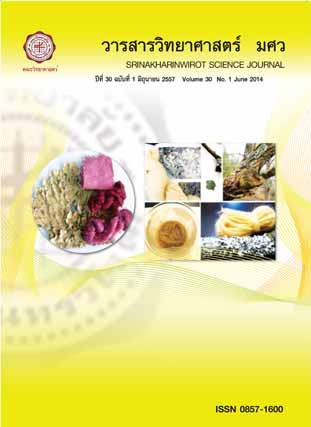สารไซเดอโรฟอร์จากจุลินทรีย์ Siderophores from Microorganisms
Keywords:
ไซเดอโรฟอร์ จุลินทรีย์ การประยุกต์ใช้ siderophores, microorganisms, applicationsAbstract
ธาตุเหล็กเป็นแร่ธาตุที่มีความสำคัญสำหรับกิจกรรมเมแทบอลิซึมและการเจริญของจุลินทรีย์ แต่พบว่าในสภาวะค่าความเป็นกรดเบสที่เป็นกลาง ธาตุเหล็กมีความสามารถในการละลายที่ต่ำมาก ดังนั้นจุลินทรีย์จึงนำเหล็กไปใช้ได้ยาก ไซเดอโรฟอร์เป็นสารที่มีมวลโมเลกุลต่ำ มีความจำเพาะต่อเฟอริกไอออน ผลิตได้จากแบคทีเรียและฟังไจบางชนิด เป็นตัวช่วยนำเหล็กเข้าสู่เซลล์จุลินทรีย์ภายใต้สภาวะแวดล้อมที่มีปริมาณเหล็กที่จำกัด หรืออยู่ในรูปที่นำไปใช้ไม่ได้ โครงสร้างและลักษณะทางเคมีของไซเดอโรฟอร์ สามารถแบ่งออกเป็นสามกลุ่มใหญ่ๆ ได้แก่ ไซเดอโรฟอร์ชนิด hydroxamates, catecholates และ carboxylates กลไกการสร้างไซเดอโรฟอร์เพื่อขนส่งเหล็กเข้าสู่เซลล์ เริ่มจากสภาวะแวดล้อมที่ขาดแคลนเหล็ก กระตุ้นให้ภายในเซลล์ของจุลินทรีย์สร้างไซเดอโรฟอร์และโปรตีนตัวรับบริเวณผนังเซลล์ขึ้นมา และปล่อยไซเดอโรฟอร์ออกสู่สิ่งแวดล้อม เมื่อเฟอริกรวมตัวกับไซเดอโรฟอร์และจับกับโปรตีนตัวรับจะถูกส่งผ่านเข้าไปภายในเซลล์เพื่อดึงเหล็กออก กลไกข้างต้นจะดำเนินไป จนกระทั่งเมื่อภายในเซลล์มีเหล็กปริมาณมากเพียงพอ สำหรับวิธีการที่นิยมใช้ตรวจสอบคุณสมบัติในการสร้างไซเดอโรฟอร์ของเชื้อจุลินทรีย์เบื้องต้น ได้แก่ การทดสอบบนอาหาร Chrome Azurol S agar (CAS agar) ในบทความนี้นำเสนอบทบาทของไซเดอโรฟอร์ที่ผลิตโดยจุลินทรีย์ โครงสร้างของไซเดอโรฟอร์ ปัจจัยที่มีผลต่อการผลิต และการนำไซเดอโรฟอร์มาประยุกต์ใช้ประโยชน์ทางด้านการเกษตร สิ่งแวดล้อม และการแพทย์ Iron is an essential element for metabolism and growth of microorganisms which is difficult to obtain due to its low solubility at neutral pH. Siderophores are low molecular weight, ferric iron-chelating ligands produced by some species of bacteria and fungi. They represent an important class of molecules that solubilize iron in the environment. These compounds facilitate iron uptake in iron-limiting environments. Chemical structures of siderophores are classified as hydroxamates, catecholates and carboxylates. Siderophores production is induced by iron-limiting conditions. The mechanism begins with synthesis of siderophores and membrane specific receptor proteins. Siderophores are released into the environment to bind with ferric irons in the environment. These ferric-bound siderophores bind with specific receptor proteins and release iron into cell. This cycle continue until the optimum level of intracellular iron is reached. The preliminary detection method for microbial siderophore production is usually tested on Chrome Azurol S agar (CAS agar). This article reviews the role of siderophores produced by microorganisms, siderophores structure, optimization of siderophore production and their applications in agriculture, environment and medicine.Downloads
Download data is not yet available.
Downloads
Published
2014-06-30
How to Cite
คำแจ่ม ม., & ปฐมอารีย์ ว. (2014). สารไซเดอโรฟอร์จากจุลินทรีย์ Siderophores from Microorganisms. Science Essence Journal, 30(1). Retrieved from https://ejournals.swu.ac.th/index.php/sej/article/view/4333
Issue
Section
บทความวิชาการ








